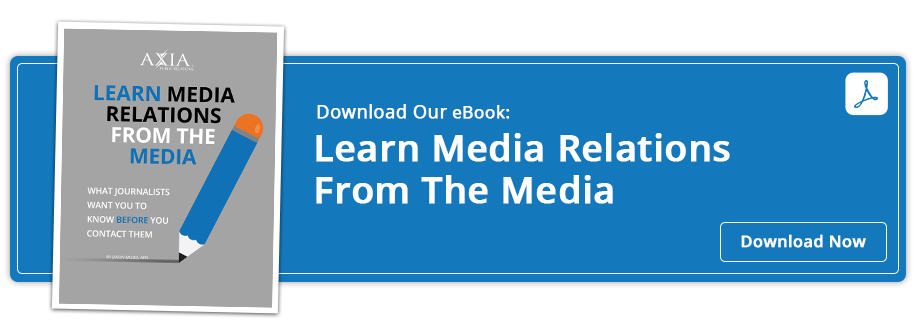Pitch stories that happen near your target audience to catch journalists’ attention.
 When pitching stories to journalists to earn media coverage, your story must stand out if you want them to accept it. As a marketing and communications professional working with news media, you need to understand what journalists look for when scanning pitches if you want them to pick up your story.
When pitching stories to journalists to earn media coverage, your story must stand out if you want them to accept it. As a marketing and communications professional working with news media, you need to understand what journalists look for when scanning pitches if you want them to pick up your story.
Audio: Listen to this article.
When journalists write, they look for stories with the greatest news value, or newsworthiness. There are several elements that make a story newsworthy. The most newsworthy story is the one the most viewers will care about. News values are how journalists categorize elements of a story that make people care.
When you consume your local news, you might notice a common topic: events happening close by. That’s at the heart of the proximity news value: A story that happens near a viewer impacts them more than a story that happens far away, so they will care more about stories in close proximity.
Incorporating proximity into your pitch
Think about the basic principles of news storytelling: who, what, when, where, why, and how. Proximity is all about the “where.” When you write your media pitch, emphasize the location if you think the story applies mainly to a location-based audience. Think about the other nine news elements — if proximity relates most to your story, you must leverage it.
Here’s an example: A city north of Dallas will receive a luxury hotel in a developing part of town in several years, but you probably haven’t heard about it unless you’re from that city. That’s because this story rides on proximity — this new hotel could drive traffic to the city, which residents will care about. But outside of that city, the event doesn’t have much impact. If you were writing a media pitch about that hotel, you would need to focus on where it was going to catch a journalist’s eye.
Here’s another: Do you remember the 2020 derecho thunderstorm that hit Central Iowa with hurricane-force winds? If you say “Yes,” are you from the Midwest? Even though this event was the most costly thunderstorm disaster in U.S. history, people who aren’t from the affected area may not remember it. This is the core of proximity: Consumers care more about stories that happen close to them.
Think about audience before you pitch
After you incorporate proximity into your news pitch, what next? Even if your story flawlessly utilizes this news value, you must pitch to the right journalists for your efforts to result in stories.
Don’t pitch to journalists from across the country just because they work at a top-tier media outlet. If proximity is one of your story’s primary news values, think about the audiences in close proximity to your story. Develop your pitch for the journalists and newsrooms that serve those audiences. This will greatly increase your pitch’s chance of success. Even if far-away newsrooms accept your pitch, their readers may not receive your story as enthusiastically as your target readers would, which is why you should pitch with a specific audience in mind.
Entrepreneur reported May 31 about a cellular service outage among T-Mobile customers on the East Coast, and the story says T-Mobile confirmed the outage to Entrepreneur via email — aka media relations. The story’s headline, “It's Not Just You: T-Mobile Appears to be Down for Customers All Over East Coast,” states the location, telling its audience where this story is newsworthy. It’s likely that T-Mobile included this in the pitch headline, too. Since T-Mobile is a large company and the outage was widespread, it makes sense to pitch this story to a top-tier media outlet. If the outage were confined to one city, local outlets would have been a better choice because of the limited impact.
Must Read: How timeliness adds news value to your story
Don’t settle for one news value
The more news elements you include in a story, the more likely journalists and readers are to care. But it’s important to remember that stories don’t need every news value, including proximity. Stories involving prominent people, odd or novel events, or scandal, for example, don’t necessarily need to happen close by to attract viewers.
Pitching stories effectively is all about getting into the mind of a journalist. Learn what journalists are saying about media pitches and sources this year to take the next step toward increasing earned media coverage.
Photo by Suzy Hazelwood from Pexels
Topics: media relations, earned media, news media


Comment on This Article